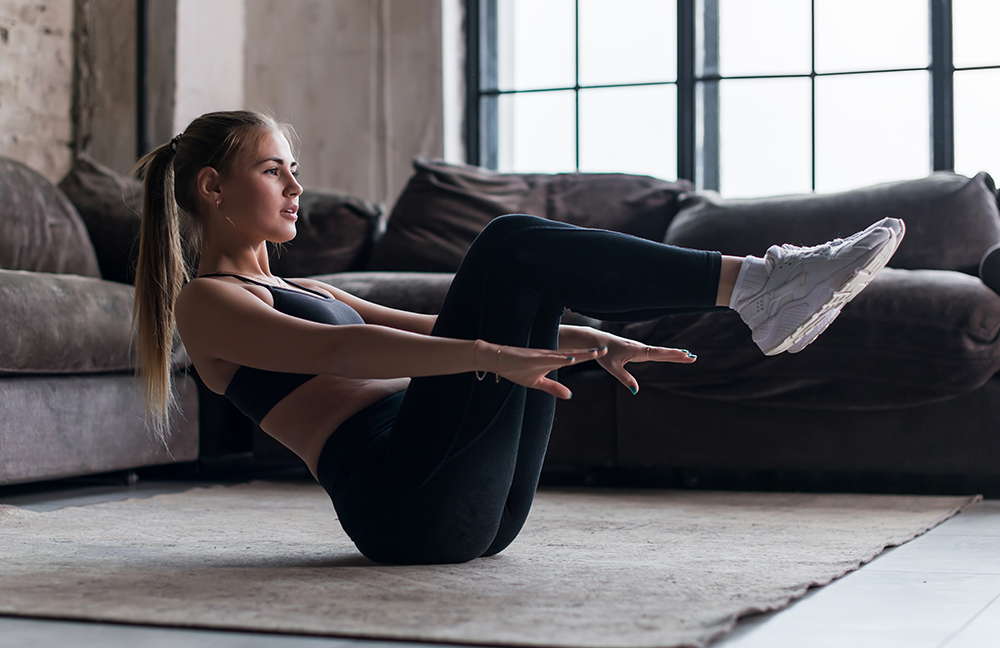Introduction
The world of fitness is evolving, and so are the ways we approach our health and wellness goals. Gone are the days when a gym membership was the only path to achieving peak fitness. Today, the Home Fitness Code Workout is transforming the way female athletes train, providing a practical and effective solution for staying fit without ever leaving home.
For female athletes, balancing the demands of daily life – whether it’s work, family, or studies – can make finding time for the gym a challenge. The Home Fitness Code is designed to simplify this journey, offering a structured and adaptable workout plan that delivers results. By focusing on key elements like consistency, adaptability, and balance, this approach empowers women to unlock their full potential, all within the comfort of their own space.
Whether you’re looking to build strength, improve endurance, or enhance flexibility, the Home Fitness Code Workout provides a step-by-step plan tailored to your needs. No matter your fitness level or the size of your living space, this program offers the tools to help you thrive.
Today’s article dives into the principles behind the Home Fitness Code, explores its benefits for female athletes, and lays out a comprehensive workout plan designed for success. Let’s get started on the journey to making fitness simple, achievable, and empowering – all from the comfort of your home.
1. Understanding the Home Fitness Code
The Home Fitness Code Workout is more than just a fitness trend – it’s a structured philosophy designed to empower female athletes to achieve their goals from the comfort of home. At its core, the Home Fitness Code focuses on three fundamental principles that make it effective, adaptable, and sustainable: consistency, adaptability, and balance.
Consistency: The Foundation of Success
Success in fitness isn’t about perfection; it’s about showing up regularly. The Home Fitness Code encourages you to establish a routine that fits seamlessly into your life. By committing to just 30-45 minutes a day, you can build strength, improve endurance, and make steady progress toward your fitness goals. For female athletes juggling work, family, or school, the convenience of training at home removes the barriers of commuting or rigid gym schedules.

Adaptability: Tailored to Your Needs
No two athletes are the same, and the Home Fitness Code recognizes that. Whether you’re a beginner or a seasoned pro, the workouts can be scaled to match your fitness level and goals. Limited space? No problem – most exercises require minimal room. Don’t have weights? Everyday items like water bottles or backpacks filled with books can work just as well. The adaptability of this code ensures that fitness is accessible to everyone, no matter their circumstances.
Balance: Holistic Wellness
Fitness isn’t just about physical strength; it’s about feeling good mentally and emotionally. The Home Fitness Code blends strength training, cardio, flexibility, and recovery exercises to create a well-rounded program. This balance not only enhances athletic performance but also reduces the risk of burnout and injuries. Female athletes can focus on building a stronger core, improving their endurance, and fostering overall well-being – all essential for peak performance.
By embracing the Home Fitness Code, you’re committing to a smarter, simpler, and more effective way to stay fit and thrive. It’s a plan designed for real lives, where progress is celebrated, and challenges are turned into opportunities. Your journey to success starts here.
2. Benefits of Home Workouts for Female Athletes
For female athletes, home workouts are more than just a convenient alternative – they’re a powerful way to stay on track with fitness goals while overcoming common obstacles like time constraints, limited resources, or accessibility to gyms. The Home Fitness Code Workout capitalizes on the unique advantages of training at home, making it an ideal solution for women striving to maintain peak performance in their athletic journeys.
Flexibility in Scheduling
One of the greatest benefits of home workouts is the ability to train on your own time. For female athletes balancing a busy schedule – whether it’s managing a career, family, or academics – the freedom to work out whenever it suits you eliminates the stress of adhering to gym hours. With the Home Fitness Code, even a short session of 20-30 minutes can be structured to deliver impactful results.
Privacy and Comfort
Home workouts provide a private environment where you can focus on your routine without distractions or self-consciousness. Whether you’re mastering a new exercise or pushing through an intense HIIT session, training at home allows you to fully engage with your goals in a setting that’s uniquely yours.

Cost-Effectiveness
Gym memberships, fitness classes, and personal trainers can be expensive. Home workouts eliminate these costs, allowing female athletes to invest in minimal equipment – like resistance bands, a yoga mat, or a set of dumbbells – and still achieve professional-level results. The Home Fitness Code emphasizes resourcefulness, showing that effective training doesn’t require a significant financial investment.
Customization for Personal Goals
At-home workouts are incredibly adaptable, making it easy to tailor your routine to specific fitness objectives. Female athletes can focus on areas most relevant to their sports, such as:
- Strength and Power: Resistance training for muscle building.
- Endurance: Cardiovascular exercises for stamina.
- Flexibility and Recovery: Yoga and stretching to reduce injury risk.
With the Home Fitness Code, every workout is an opportunity to design a plan that works for you.
Accessibility and Convenience
Forget long commutes or waiting for machines at a crowded gym. Home workouts remove these barriers, making fitness accessible no matter where you live. Whether you’re in a city apartment, a suburban home, or traveling, the Home Fitness Code ensures you’re never far from your next workout.
Maintaining Consistency
The ease of training at home reduces the likelihood of skipping workouts. Without the need to travel or plan around gym schedules, consistency becomes far more achievable. This is crucial for female athletes striving to maintain momentum and see steady progress.
Empowering Your Fitness Journey
The Home Fitness Code Workout leverages these benefits to create a system that aligns with the demands of modern life while keeping female athletes motivated and on track. By embracing the flexibility, affordability, and convenience of home workouts, you can take control of your fitness journey – turning challenges into opportunities and building a strong foundation for success.
3. Key Elements of an Effective Home Workout Plan
A successful home workout plan doesn’t just happen – it’s built on a foundation of carefully chosen elements that ensure balance, efficiency, and sustainability. The Home Fitness Code Workout incorporates these essential components to help female athletes maximize results and stay motivated, all while working out in the comfort of their homes.
Warm-Up: Preparing Your Body
Every effective workout begins with a warm-up to increase blood flow, activate muscles, and prevent injuries. For female athletes, this step is particularly crucial to enhance performance and mobility. A dynamic warm-up for the Home Fitness Code could include:
- Jumping jacks (1 minute)
- Arm circles (30 seconds each direction)
- Leg swings (10 reps per leg)
- High knees (1 minute)
Warming up sets the tone for a productive session and primes your body for the exercises ahead.
Strength Training: Building Power
Strength training is the cornerstone of athletic performance, helping female athletes develop muscle, improve bone density, and enhance overall strength. The Home Fitness Code emphasizes:
- Bodyweight Exercises: Push-ups, squats, and lunges require no equipment and target key muscle groups.
- Minimal Equipment Workouts: Incorporate resistance bands, dumbbells, or kettlebells for added intensity.
- Progressive Overload: Gradually increase reps, resistance, or time under tension to keep your muscles challenged. Learn more about progressive overload here.
Strength training is essential for everything from improving endurance to reducing the risk of injury.
Cardiovascular Fitness: Boosting Endurance
Cardio is vital for female athletes to improve heart health, stamina, and calorie burn. The Home Fitness Code offers a variety of ways to incorporate cardio, even in small spaces:
- High-Intensity Interval Training (HIIT): Quick bursts of effort followed by rest periods (e.g., 20 seconds of mountain climbers followed by 10 seconds of rest).
- Low-Impact Options: For joint-friendly cardio, try step-ups, marching in place, or shadow boxing.
- Endurance Drills: Incorporate sustained activities like jump rope or running on the spot for a steady burn.
Cardio exercises keep your energy levels high and your heart strong.
Flexibility and Recovery: Enhancing Mobility
Flexibility and recovery are often overlooked but are critical for female athletes aiming to optimize their performance. Stretching improves mobility, relieves muscle tension, and reduces soreness. Incorporate:
- Yoga flows focusing on hip and shoulder mobility.
- Static stretches targeting hamstrings, quads, and calves.
- Foam rolling or self-massage to release tight muscles.
Recovery days with light activity or focused stretching ensure long-term consistency and performance.

Tracking Progress: Staying Accountable
Consistency thrives on measurable progress. The Home Fitness Code encourages athletes to track their workouts and celebrate milestones. Use a fitness tracker app, journal, or even a calendar to log:
- Reps completed and weights used.
- Duration of cardio sessions.
- Improvements in flexibility and mobility.
Tracking progress keeps you motivated and ensures steady growth.
Time Management: Maximizing Efficiency
Home workouts are designed to be efficient, with each session lasting between 20 and 45 minutes. The Home Fitness Code uses circuit training and supersets to maximize effort in minimal time. For example:
- Circuit Example: Squats, push-ups, and planks performed back-to-back with no rest in between.
- Superset Example: Pairing lunges with overhead presses to target different muscle groups in one set.
This efficient approach ensures you stay on track without compromising your daily schedule.
4. The Home Fitness Code Workout Plan for Female Athletes
Now that you understand the principles and essential elements of the Home Fitness Code, it’s time to put it into action. This workout plan is specifically designed to support female athletes, focusing on building strength, enhancing endurance, and improving flexibility—all while fitting seamlessly into your home environment. The plan balances intensity with recovery to maximize results and keep you consistent.
Weekly Workout Plan Overview
Day 1: Lower Body Strength
Focus on building strong, powerful legs and glutes with these foundational moves:
| Exercise | Sets / Reps |
|---|---|
Bodyweight Squats | 3 sets of 15 reps. |
Lunges (Alternating Legs) | 3 sets of 10 reps per leg. |
Glute Bridges | 3 sets of 12 reps. Use a resistance band for added challenge. |
Calf Raises | 3 sets of 15 reps. Hold dumbbells or a household item for extra resistance. |
Day 2: Upper Body and Core
Strengthen your arms, shoulders, and core with these effective exercises:
| Exercise | Sets / Reps |
|---|---|
Push-Ups (Standard or Knee) | 3 sets of 10-15 reps. |
Dumbbell Rows (or use water bottles) | 3 sets of 12 reps per arm. |
Plank | 3 sets of 20 taps (10 per side). |
| Russian Twists (Bodyweight or Weighted) | 3 sets of 20 twists (10 per side). |
Day 3: Active Recovery (Yoga and Mobility)
Take a break from intense training with a session focused on flexibility and mobility:
- Sun Salutations: Perform 3-5 rounds to warm up.
- Hip Openers (e.g., Pigeon Pose): Hold for 30 seconds per side.
- Child’s Pose and Cat-Cow Stretch: Hold each position for 30 seconds.
- Hamstring Stretches: Hold for 30 seconds per leg.
Day 4: HIIT Cardio
Boost your cardiovascular endurance with high-intensity interval training:
Circuit (repeat 3 times):
- 30 seconds of Jumping Jacks.
- 30 seconds of Mountain Climbers.
- 30 seconds of Burpees.
- 1-minute Rest.
Day 5: Full-Body Strength
Combine upper and lower body movements to build overall strength and coordination:
| Exercise | Sets / Reps |
|---|---|
Kettlebell or Backpack Swings | 3 sets of 15 reps. |
Overhead Press (Dumbbells or Household Items) | 3 sets of 12 reps. |
Sumo Squats | 3 sets of 10 reps. |
Lying Leg Raises | 3 sets of 12 reps per side. |
Day 6: Endurance and Core
Focus on endurance with a steady-state cardio session and core work:
| Exercise | Sets / Reps |
|---|---|
Shadow Boxing | 3 rounds of 3 minutes each, with 1-minute rest between rounds. We have a great boxing app, download it here. |
Plank Variations (Side Plank, Forearm Plank) | 3 sets of 30-45 seconds each. |
Lying Leg Raises | 3 sets of 15 reps. |
Day 7: Rest or Light Activity
Allow your body to recover with a light activity or rest day:
- Gentle Stretching: Focus on areas that feel tight or sore.
- Optional Walk: A 20-30 minute stroll at a relaxed pace.
Tips for Success
- Modify as Needed: Adjust reps, sets, or intensity to suit your fitness level.
- Stay Consistent: Aim to complete at least 5-6 days of activity each week.
- Prioritize Form: Focus on proper technique to avoid injury and maximize benefits.
- Track Your Progress: Log your workouts to monitor improvements and stay motivated.
For many more great workout ideas (gym workouts and home workouts), check out our Blaze database:
The Results You’ll Achieve
By following this plan, you’ll gain strength, boost endurance, and enhance flexibility – all key elements for female athletes. More importantly, you’ll build a sustainable fitness routine that adapts to your lifestyle, ensuring long-term success and empowerment. The Home Fitness Code Workout is your blueprint for achieving greatness, one workout at a time.
5. Adapting the Plan to Individual Needs
One of the most powerful aspects of the Home Fitness Code Workout is its adaptability. Every athlete has unique goals, fitness levels, and living environments, which is why this plan is designed to be flexible and inclusive. Whether you’re a beginner, an intermediate exerciser, or an advanced athlete, the workout plan can be adjusted to meet your specific needs and maximize your results.
Modifying Intensity Levels
Not every workout will feel the same for every individual. Here’s how to adjust the intensity:
- For Beginners: Reduce the number of sets and reps for each exercise. Focus on mastering form before increasing intensity. For example, start with 2 sets instead of 3 and perform 8-10 reps.
- For Intermediate Athletes: Stick to the recommended sets and reps while maintaining proper form. Consider incorporating lightweight equipment, like resistance bands or small dumbbells.
- For Advanced Athletes: Increase the intensity by adding more weight, performing extra sets, or reducing rest time between exercises. Advanced athletes can also incorporate plyometric moves, like jump squats or explosive push-ups.
Adjusting for Space Constraints
Training at home often means working within limited space. Luckily, the Home Fitness Code is adaptable:
- Small Spaces: Focus on exercises that don’t require much room, such as planks, squats, and seated dumbbell presses. HIIT workouts can be modified to eliminate lateral movements if space is tight.
- Outdoor Options: If you have access to a yard or park, expand your routine to include sprint intervals or walking lunges.
Customizing for Specific Goals
Your fitness goals will shape how you approach the Home Fitness Code Workout:
- Building Strength: Focus on resistance-based exercises and progressively increase weights or resistance levels over time.
- Improving Endurance: Incorporate longer cardio sessions or high-rep, low-weight strength routines.
- Enhancing Flexibility: Add more yoga or mobility sessions, extending recovery days as needed.
- Losing Weight: Prioritize high-intensity cardio and circuit training to maximize calorie burn while maintaining muscle mass.
Adapting for Equipment Availability
The Home Fitness Code is designed to work with or without equipment, making it perfect for athletes with varying resources:
- No Equipment: Stick to bodyweight exercises like push-ups, planks, and lunges.
- Minimal Equipment: Use resistance bands, water bottles, or backpacks filled with books as substitutes for dumbbells or kettlebells.
- Advanced Equipment: If you have access to weights or machines, incorporate them to increase intensity and add variety.
Balancing Workouts and Recovery
Recovery is just as important as the workouts themselves. Here’s how to balance your schedule:
- Active Recovery Days: Substitute high-intensity sessions with light yoga, stretching, or walking to give your body a break.
- Listen to Your Body: If you’re feeling sore or fatigued, scale back your workout or skip a session to prevent overtraining.
- Incorporate Rest Days: Rest is vital for muscle repair and growth. Aim for at least one complete rest day each week.
Incorporating Personal Preferences
Enjoyment plays a significant role in maintaining consistency. Tailor the Home Fitness Code Workout to include activities you love:
- Swap out a HIIT session for a dance workout or Pilates class.
- Replace shadow boxing with jump rope or brisk walking if you prefer.
- Experiment with different exercises to keep your routine fresh and exciting.
6. Tracking Progress and Staying Motivated
Consistency and motivation are key to long-term success in any fitness journey, and the Home Fitness Code Workout makes it easy to track progress and stay inspired. By measuring your achievements, celebrating milestones, and maintaining a positive mindset, you can turn your home workout routine into a lifestyle.
Why Tracking Progress is Essential
Monitoring your progress helps you:
- Stay Accountable: Knowing you’re logging each workout encourages consistency.
- Measure Results: See how your strength, endurance, and flexibility improve over time.
- Identify Areas of Improvement: Adjust your routine to focus on weak points or achieve specific goals.
Tracking your journey also serves as a reminder of how far you’ve come, keeping you motivated to push further.
Workout Tracking
With Blaze Workout, you have access to a huge variety of metrics. This allows you to review your progress over time under different angles.
Take your workout to the next level!
Tools to Track Your Fitness Progress
Tracking your workouts doesn’t need to be complicated. Here are a few methods to consider:
- Fitness Apps: Use apps to log exercises, sets, reps, and progress photos.
- Journaling: Keep a fitness journal to jot down daily workouts, personal bests, and how you feel after each session.
- Progress Photos: Take photos every few weeks to visually document your transformation.
These tools give you tangible proof of your efforts, boosting confidence and motivation. Download our free iOS fitness app for workout planning and tracking. It is the go-to workout tracker on the AppStore to plan, track, analyze your workout progress. It even has five different virtual coaches to help and motivate you on your fitness journey:
Setting Goals and Celebrating Milestones
Having clear goals keeps you focused and motivated. The Home Fitness Code encourages setting:
- Short-Term Goals: For example, completing 10 push-ups or holding a plank for one minute.
- Long-Term Goals: Such as improving overall strength, losing a specific amount of weight, or achieving better flexibility.
Celebrate your wins, no matter how small. Reward yourself with something that aligns with your goals, like new workout gear, a healthy treat, or a relaxing self-care day.
Overcoming Motivation Slumps
It’s natural to experience dips in motivation, but the Home Fitness Code offers strategies to keep you on track:
- Create a Routine: Set a specific time each day for your workouts to make them a habit.
- Join Online Communities: Connect with others following similar fitness journeys to share tips and encouragement.
- Visualize Success: Imagine how good you’ll feel after completing your workout or achieving your goals.
- Mix Things Up: Prevent boredom by switching exercises, trying new formats like yoga or HIIT, or working out in a different space.
Motivation is like a muscle – keep working on it, and it will grow stronger.
The Power of Positive Mindset
Your mindset plays a crucial role in staying motivated. Instead of focusing on setbacks or missed workouts, celebrate your commitment to improving your health. Remind yourself that fitness is a journey, not a destination, and progress takes time.
Accountability: A Game-Changer
Finding an accountability partner can significantly boost your commitment. This could be a friend, family member, or even an online coach. Share your goals, check in regularly, and motivate each other to stay consistent.
7. Common Challenges and Solutions
Even with the best workout plan, challenges are inevitable. Life gets busy, motivation dips, and unexpected obstacles arise. The Home Fitness Code Workout acknowledges these realities and equips female athletes with strategies to overcome them, ensuring consistency and progress even when things don’t go as planned.
Challenge: Lack of Motivation
Solution: Focus on Your Why
- Reflect on your reasons for starting the Home Fitness Code Workout. Are you aiming for strength, confidence, or overall health? Keep these goals at the forefront of your mind.
- Break your goals into smaller, manageable steps to avoid feeling overwhelmed.
- Create a workout playlist with your favorite energizing songs to make your sessions more enjoyable.
Solution: Build a Support System
- Join online communities or fitness groups where you can share progress and challenges.
- Find an accountability partner to keep each other motivated.
Challenge: Limited Space
Solution: Optimize Your Environment
- Declutter a small area in your home to create a dedicated workout space.
- Choose exercises that require minimal movement, such as planks, push-ups, or squats.
- If weather permits, take your workout outdoors for a change of scenery.
Solution: Adapt Exercises
- Modify exercises to fit your available space. For example, replace lateral lunges with step-backs or reduce the range of motion for movements.
Challenge: Equipment Limitations
Solution: Use What You Have
- Substitute household items for traditional equipment. For instance, water bottles can replace dumbbells, and a sturdy chair can be used for tricep dips.
- Invest in affordable equipment like resistance bands, which are versatile and space-saving.
Solution: Focus on Bodyweight Movements
- Bodyweight exercises like push-ups, lunges, and planks are highly effective and don’t require any tools.
Challenge: Time Constraints
Solution: Prioritize Short Workouts
- Opt for high-intensity interval training (HIIT) sessions that deliver results in as little as 15-20 minutes.
- Break your workout into smaller chunks throughout the day if you can’t commit to a single session.
Solution: Plan Ahead
- Schedule your workouts just like any other appointment. Block out time on your calendar and treat it as non-negotiable.
Challenge: Plateaus in Progress
Solution: Mix Up Your Routine
- Change your exercises, rep ranges, or intensity levels to keep your body challenged.
- Add new types of workouts, such as yoga, Pilates, or boxing, to engage different muscle groups.
Solution: Track and Adjust
- Use a fitness tracker or journal to identify areas where you can improve. If strength is stagnating, consider increasing resistance or volume.
Challenge: Distractions at Home
Solution: Set Boundaries
- Communicate with family or roommates about your workout schedule to minimize interruptions.
- Train early in the morning or late in the evening when distractions are fewer.
Solution: Create a Focused Atmosphere
- Eliminate distractions by turning off your phone notifications and playing upbeat music to stay in the zone.
Challenge: Fear of Improper Form
Solution: Educate Yourself
- Watch instructional videos or tutorials to ensure you’re performing exercises correctly.
- Use a mirror to check your form or record yourself for feedback.
Solution: Start Simple
- Focus on mastering basic movements before progressing to more complex exercises. Proper form is better than heavy resistance when it comes to results and injury prevention.
Challenge: Overcoming Burnout
Solution: Listen to Your Body
- Recognize the signs of burnout, such as persistent fatigue or loss of motivation, and adjust your schedule to allow for rest.
- Incorporate active recovery days with light activities like stretching or walking.
Solution: Reignite Your Passion
- Set new goals or try a different workout style to reignite your excitement for fitness.
- Celebrate your achievements, no matter how small, to remind yourself of how far you’ve come.
Conclusion
The Home Fitness Code Workout is more than just a routine – it’s a mindset and a lifestyle that empowers female athletes to take control of their fitness journeys. By embracing the principles of consistency, adaptability, and balance, you can achieve remarkable results from the comfort of your own home, no matter your fitness level or available resources.
This blog has covered every aspect of the Home Fitness Code, from understanding its foundations to crafting a personalized workout plan, tracking progress, and overcoming challenges. Whether your goal is to build strength, boost endurance, improve flexibility, or simply stay active, this approach is designed to simplify the process and make fitness an enjoyable part of your daily life.
Remember, fitness is a journey, not a destination. The key to long-term success lies in small, consistent actions that add up over time. With the Home Fitness Code Workout, you have everything you need to thrive – tools to stay motivated, a flexible plan that adapts to your needs, and the confidence to tackle any obstacle in your path.
So, what are you waiting for? Step into your living room, roll out your mat, and start moving. Your best self is just a workout away. Embrace the Home Fitness Code Workout and unlock your full potential today!













